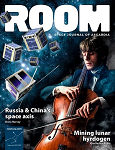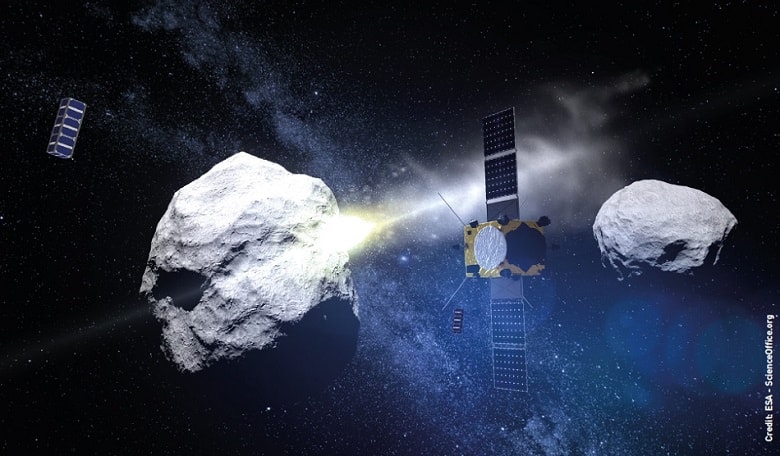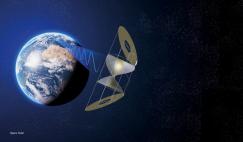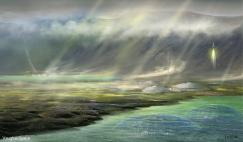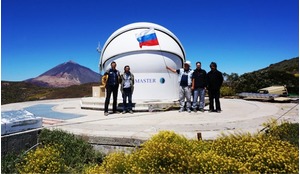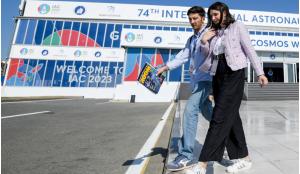If it gets the go-ahead, the Asteroid Impact Mission (AIM) will be the first spacecraft to visit a binary asteroid system and ESA’s first mission to a small body since Rosetta landed on a comet. With its micro lander and accompanying flock of CubeSats, AIM will be a technology demonstration mission as well as a science study. Most excitingly, it will observe the collision of a NASA spacecraft with the asteroid and collect data that could save Earth from future impacts
The Asteroid Impact Mission (AIM) is a candidate mission currently in preparation, due to be presented for approval by the European Space Agency’s Council of Ministers in November 2016. If approved, AIM must be built and ready to fly for a firm October/November 2020 launch window in order to reach the Didymos binary asteroid system by June 2022. AIM will be humanity’s very first mission to a binary asteroid system and ESA’s first mission to a small body since the Rosetta comet-chaser. At the same time, AIM is a distinct type of interplanetary mission: innovative, low cost and notably faster.
In the past, such deep space endeavours have involved prodigious amounts of time as well as space. Rosetta, for instance, was in development for more than a decade before it flew (a last-minute launcher problem famously leading it to miss its original launch window and target). It then took another 10 years’ worth of planetary flybys to finally achieve its triumphant rendezvous with Comet 67P/Churyumov–Gerasimenko.
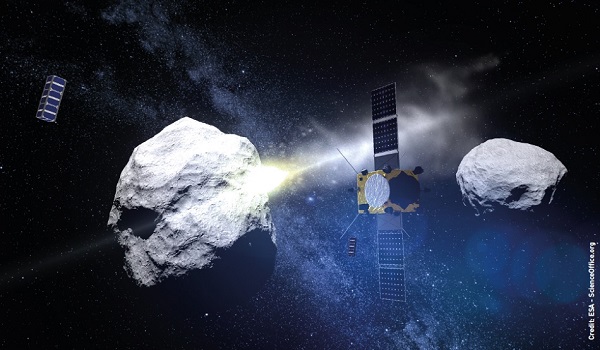 The AIM spacecraft observes NASA’s DART mission smashing into one half of the Didymos binary asteroid system
The AIM spacecraft observes NASA’s DART mission smashing into one half of the Didymos binary asteroid system
By necessity, AIM has had to take shape at a more rapid pace. Its target is providing a one-of-a-kind celestial encounter in October 2022, enabling a unique mission opportunity. Channelling lessons learned from previous interplanetary missions like Rosetta is a fundamental element of the endeavour. By meeting the fixed launch window deadline, AIM will be able to reach its target within a year and a half, and play a vital part in a challenging international experiment.
The sheer size of the DART impact dwarfs anything that can be replicated in a terrestrial laboratory
The 800m-diameter main body is orbited by a 170m moon, informally called ‘Didymoon’. At the time AIM arrives, the orbit of these two asteroids will bring them a comparatively close 11 million km to Earth, enabling a complementary ground-based campaign of observation. The smaller moon will be AIM’s main subject of study, although measurements of the larger asteroid will be made when the opportunity arises. AIM will not long be alone at Didymos, however: an important conjunction is anticipated. A second NASA-led spacecraft will arrive approximately four months after AIM. The Double Asteroid Redirection Test (DART) probe will home in on the smaller asteroid moon – then crash straight into it at about 6km/s. DART, designed by the Johns Hopkins University’s Applied Physics Laboratory (APL), will test the feasibility of diverting the path of an asteroid. It will be a ground-breaking experiment in planetary defence techniques. AIM itself will perform detailed before-and-after comparisons on the structure of the body, as well as its orbit, to characterise DART’s kinetic impact and its consequences.
The two missions are together known as the Asteroid Impact & Deflection Assessment mission (AIDA). In a new model of international cooperation, these two separate spacecraft are being planned in coordination to maximise their overall scientific return on investment. However, both spacecraft can still pursue their own missions independently. If, for some reason, one of the spacecraft cannot contribute to the joint campaign, the other would still be able to achieve its individual mission goals.
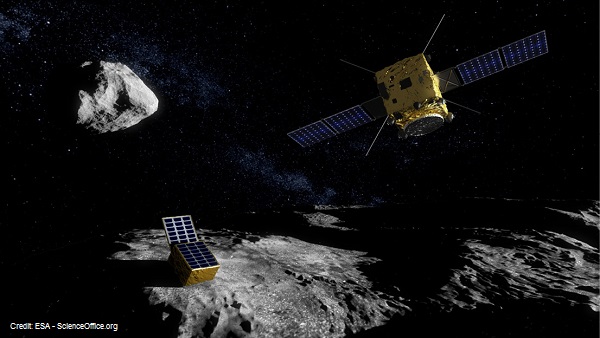 The micro lander MASCOT-2 will operate for weeks on Didymoon, taking soundings through the asteroid
The micro lander MASCOT-2 will operate for weeks on Didymoon, taking soundings through the asteroid
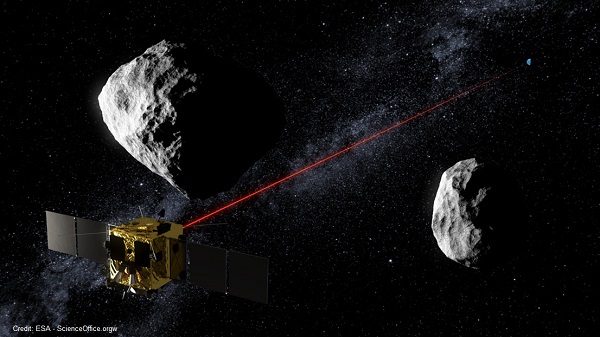 AIM’s laser will serve a dual purpose: communications with Earth and scientific studies of the asteroid
AIM’s laser will serve a dual purpose: communications with Earth and scientific studies of the asteroid
The AIDA collision can be compared to the 2005 impact of NASA’s Deep Impact probe with Comet Tempel 1. But while that target body was 6km in diameter, Didymoon is only 170m across. (Deep Impact’s aim was not to deflect the comet but to reveal its subsurface.) This requires much more precise navigation, while also making some modification of its orbit around the primary asteroid feasible. Unexpected events during the Tempel 1 impact and the fast-moving camera on the flyby spacecraft meant that the ensuing crater was not glimpsed; many parameters needed to reconstruct the cratering event were lost. With AIM on station this will not be the case again – the mission will be equipped to investigate and capture all aspects of DART’s impact, additionally supported by observations from Earth.
Trialling new technology
The Didymos system’s especially close approach to Earth in 2022 presents a unique opportunity to perform such an experiment on so vast a scale. The fundamental measurement that AIDA will make possible is that of the variation of the orbital period of Didymoon around its parent ‘Didymain’ after the impact. This value can be obtained based on measurements of light curves – or variations in brightness over time. This is a well-established, occultation-based method of exoplanet modelling. But from the distance involved, the measurement could also be performed for the Didymos system using much smaller telescopes. Once fully documented and understood, kinetic impact for asteroid deflection will then be a technique that could feasibly be applied to other targets should the need arise.
Planned to be launched by a Soyuz-Fregat launcher from Europe’s Spaceport in French Guiana, AIM will have a projected launch mass of 800kg – less than a third of Rosetta’s launch mass. Measuring 1.8 x 2.0 x 2.1m across with solar arrays stowed, the spacecraft design is a simple one with fixed solar arrays, a fixed high-gain antenna and a bipropellant propulsion system with 24 10-Newton thrusters.
Once understood, kinetic impact for asteroid deflection could feasibly be applied to other targets should the need arise.
ESA envisages AIM first and foremost as a technology demonstration mission. It will trial deep-space optical communications techniques, inter-satellite communications between AIM, its CubeSats and a micro lander, and proximity operations in low gravity. All are applicable to future missions. Such technologies have been selected and used in the mission so that they can directly benefit from already on-going developments in other ESA programmes and missions, thus providing a robust and credible plan for such a short mission implementation.
Following past European technology-testing missions such as the Smart-1 lunar orbiter and the Proba series of Earth- and Sun-monitoring minisatellites, ESA believes that the best proof that new technologies can indeed perform as envisaged is to utilise them in useful scientific investigations. But to achieve meaningful science within the available budget, mass and time envelope required an extremely tight and inventive focus in terms of mission design, with no room for additional trade-offs or other options.
AIM is therefore undergoing very focused and streamlined design work with many trade-off options already closed through numerous past ESA studies on asteroid missions. For instance, during its 18 months of travel – the bulk of AIM’s time in space – the spacecraft will remain largely inactive, transmitting only basic telemetry, as a means of minimising operational costs. The truly active phase of the mission will last a scant six months. And AIM’s hardware has been designed with an interdisciplinary multi-tasking manner in mind. For example, the visual imaging system performing guidance and navigation on the way to Didymos is also being utilised to achieve the main mission objective. It will measure the Didymoon period change, map the asteroid surface on arrival, and retrieve a wealth of scientific data. And the laser being used for two-way optical communications back to Earth will also be performing laser-ranging with the asteroid for both close proximity operations and scientific studies.
Four spacecraft in one
A combination of visual and thermal imagers will survey the asteroid surface. The thermal imager (which could also function as the receiving end of the optical communications terminal) will serve to discriminate between different possible surface properties of Didymoon, such as bare rock versus granular or dusty surfaces. Its secondary goal is to measure the thermal properties of the asteroid surface relevant to characterising the soil structure and cohesion, as well as other thermal effects thought to influence asteroid motion. These investigations will be complemented by high frequency radar to characterise the outermost surface and sub-surface layers, up to a depth of 10m. Additional low-frequency radar will peer deeper into the asteroid interior, albeit at lower resolution. The copious amounts of data expected to be generated by the AIM payload will be returned to Earth via the aforementioned laser system, maintaining a high-bandwidth link to ESA’s Optical Ground Station in Tenerife.
This fixed payload will be joined by more mobile elements, effectively making the AIM mission four spacecraft in one. The main ‘mothership’ will also carry the MASCOT-2 (Mobile Asteroid Surface Scout-2) micro lander, supplied by the German Aerospace Center DLR. It’s a direct descendant of the MASCOT-1 lander currently aboard JAXA’s Hayabusa-2 mission, embarked on a mission to Near-Earth Asteroid 1999 JU3 for a 2018 touchdown. MASCOT-2 will be largely identical to its predecessor, building on its heritage with two main changes: accommodation of low-frequency radar transmitter antennas – allowing AIM to perform soundings right through the asteroid – and a solar panel to survive several weeks on the Didymoon surface.
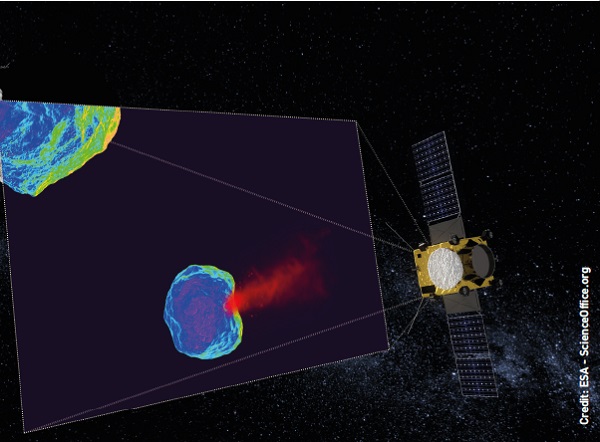 The moment of the DART spacecraft’s impact with the asteroid will be observed in infrared
The moment of the DART spacecraft’s impact with the asteroid will be observed in infrared
The shoe-box sized lander will also host an infrared spectrometer to analyse the composition of Didymoon’s surface, a magnetometer to investigate its magnetic field, a wide-angle camera to record the landing site and fine soil structure, and a radiometer to measure surface temperature among other values. The haphazard touchdown of Rosetta’s Philae lander demonstrates the challenges inherent in low-gravity operations, but MASCOT-2 will be an opportunity to acquire added experience and knowledge.
AIM will also be carrying two CubeSats. This early demonstration of CubeSats in deep space will facilitate valuable inter-satellite communication and data relay experiments, opening the door to a future in which micro satellites could attempt tasks too risky for standard spacecraft. Mastering the maintenance of communications and rendezvous operations between separate spacecraft in interplanetary space will be essential for planned sample-return missions to Mars or other bodies.
The mission has put out an announcement of opportunity for use of these CubeSat Opportunity Payloads (COPINS) – innovative ideas for CubeSat-hosted sensors that will boost and complement AIM’s own scientific return. AIM has room for a total of six CubeSat units. Potentially that might mean as many as six different one-unit CubeSats could fly, but in practice it might turn out that two three-unit CubeSats will be needed to produce a meaningful scientific return.
The mission as a whole is likely to contribute to asteroid science at a fundamental level. In recent years the combination of in-situ missions, ground-based observations, meteorite analysis and software modelling has revealed the striking variety of asteroids in terms of size, shape and constituent materials. But what factors drove this diversity? How did their chaotic features arise, studded with craters, variously heaped with pebbles or dust while often exhibiting dynamic behaviour such as avalanches, landslides and seismic events? Each new close encounter with a different asteroid has led to a fresh transformation in our understanding, but there is still much to learn – starting with the way they move.
What we hope to learn
Asteroids rotate in various ways, from simple rotation to precession or tumbling. It evolves due to a variety of torques and mechanisms affecting their spin properties. Ground-based observations are providing information on typical asteroid rotation states, suggesting the influence of an array of mechanisms. There is some suggestion that asteroid rotation is constrained by ‘spin limits’, beyond which centrifugal acceleration would cause material to escape from non-monolithic ‘rubble pile’ asteroids. Indeed, this might be the origin of many binary asteroid systems, which form 15% of the known total. And photon pressure on an irregular asteroid body can induce rotational torque – known as the ‘Yarkovsky/YORP effect’.
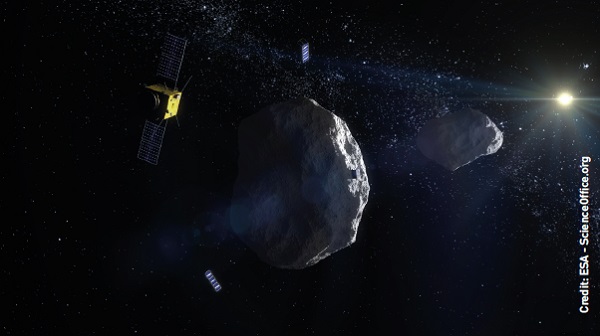 The micro lander and CubeSats will form a network to demonstrate how data can be relayed in space
The micro lander and CubeSats will form a network to demonstrate how data can be relayed in space
AIM can provide ‘ground-truth’ for ground-based observations and modelling, in terms of the formation mechanisms of binary systems and the geophysics of asteroids. As part of AIDA, AIM will shed new light on collisional dynamics. This is increasingly recognised as an important factor not only in the creation of asteroids but also in the formation and ongoing history of the Solar System, potentially even in creating the preconditions for life on Earth. The sheer size of the DART impact dwarfs anything that can be replicated in a terrestrial laboratory. Extrapolations by more than 15 orders of magnitude are required today to reach the scale corresponding to asteroids, and such extrapolations are impossibly optimistic in their assumptions.
In reality, asteroids are complex and varied entities whose impact behaviour might have very little in common with the rocks or fluid spheres currently used as laboratory analogues. Observations and density measurements conclude that they are largely formed of aggregates, held loosely together. Yet their internal structure remains a blank spot in our understanding. Are there large voids within the deep interior of asteroids, loosely-packed soil or conglomerates of monolithic rock? There is no real way of knowing how an actual asteroid would respond to such an external stimulus – short of trying it for real.
Other ‘known unknowns’ are the precise physical phenomena apart than the extremely low gravity that govern the surface character of asteroids, influence their mechanical properties and keep them bound together. What are the relative roles of electrostatic and Van der Waals forces, for a start? One proposal has been that some fine-grained asteroids might be ‘fairy castles’, likely to collapse into dust at the slightest touch. As well as being essential to future asteroid miners as well as planetary defence planners, practical insight from AIM into the fundamental processes driving asteroid cohesion could have much wider implications – offering a window back to the very earliest microscopic-scale processes of accretion right back to the dawn of this and indeed other Solar Systems.
Finally, AIDA is the opportunity to materialize international technical, political and programmatic endeavours supported by the United Nations Committee on the Peaceful Uses of Outer Space (UN COPUOS) over the last 15 years: what should humanity do if an asteroid were on a collision course with Earth? With that as the goal, the potential for public engagement in this mission is likely to be huge.


